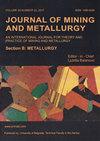纯钒中溶解氧和氢的热力学行为
IF 1
4区 材料科学
Q3 METALLURGY & METALLURGICAL ENGINEERING
Journal of Mining and Metallurgy Section B-Metallurgy
Pub Date : 2021-01-01
DOI:10.2298/jmmb210108037z
引用次数: 0
摘要
钒金属的脱氧机理被认为是基本知识;然而,在现有文献中尚未得到阐明。本文总结了V-H-O体系的热力学数据,并计算了主要化合物的吉布斯自由能。因此,不同的还原剂在一个V-O系统的脱氧极限进行了评估,即:Si, Al和Mg。结果表明,Si对v中O的去除率低于7.27 wt%,而Al是较强的还原剂;在800℃和1050℃下,O的去除率分别高达0.01 wt%和0.1 wt%。然而,Mg表现出最好的还原性能,在1100℃时,它可以去除少于0.01 wt%的O。H2的加入使V-O固溶体在一定程度上变得不稳定,说明H2有利于脱氧。平衡条件分析结果与V-O体系脱氧极限分析结果吻合较好。也就是说,本研究表明,通过改变还原剂的用量和温度,可以有效地控制钒中的氧。本文章由计算机程序翻译,如有差异,请以英文原文为准。
Thermodynamic behavior of dissolved oxygen and hydrogen in pure vanadium
The mechanism governing the deoxidation of vanadium metal is regarded as fundamental knowledge; however, it has not been elucidated in existing literature. In this paper, the thermodynamic data of V-H-O systems were summarized, and the Gibbs free energies of the main compounds were calculated. Consequently, the deoxidation limits of different reductants in a V-O system were evaluated, namely: Si, Al, and Mg. It was observed that Si cannot remove an O content of less than 7.27 wt% from V. However, Al was the stronger reducing agent; it could remove O contents of up to 0.01 and 0.1 wt% at 800 and 1050 ?C, respectively. Nevertheless, Mg exhibited the best reducing properties as it could remove less than 0.01 wt% of O at 1100 ?C. The addition of H2 renders the V-O solid solution unstable to a certain extent, thereby indicating that H2 facilitates deoxygenation. Furthermore, the results obtained by analyzing the equilibrium conditions were in accordance with the results of the deoxidation limit in the V-O system. In other words, this study demonstrates that the oxygen in vanadium can be effectively controlled by changing the reductant dosage and temperature.
求助全文
通过发布文献求助,成功后即可免费获取论文全文。
去求助
来源期刊
CiteScore
2.00
自引率
40.00%
发文量
19
审稿时长
2 months
期刊介绍:
University of Belgrade, Technical Faculty in Bor, has been publishing the journal called Journal of Mining and Metallurgy since 1965 and in 1997 it was divided in two independent journals dealing with mining and metallurgy separately. Since 2009 Journal of Mining and Metallurgy, Section B: Metallurgy has been accepted in Science Citation Index Expanded.
Journal of Mining and Metallurgy, Section B: Metallurgy presents an international medium for the publication of contributions on original research which reflect the new progresses in theory and practice of metallurgy. The Journal covers the latest research in all aspects of metallurgy including hydrometallurgy, pyrometallurgy, electrometallurgy, transport phenomena, process control, solidification, mechanical working, solid state reactions, materials processing, surface treatment and relationships among processing, structure, and properties of materials.

 求助内容:
求助内容: 应助结果提醒方式:
应助结果提醒方式:


